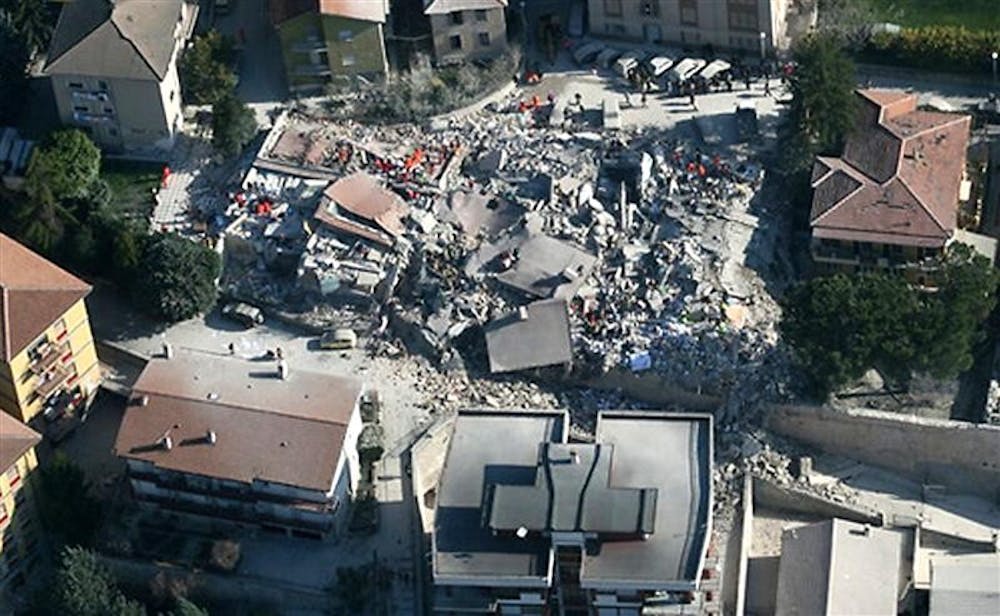L'AQUILA, Italy - A powerful earthquake in mountainous central Italy knocked down whole blocks of buildings early Monday as residents slept, killing more than 70 people in the country's deadliest quake in nearly three decades, officials said. Tens of thousands were homeless and 1,500 were injured.
Ambulances screamed through the medieval city L'Aquila as firefighters with dogs worked feverishly to reach people trapped in fallen buildings, including a dormitory where half a dozen university students were believed still inside.
Outside the half-collapsed building, tearful young people huddled together, wrapped in blankets, some still in their slippers after being roused from sleep by the quake. Dozens managed to escape as the walls fell around them.
"We managed to come down with other students but we had to sneak through a hole in the stairs as the whole floor came down," said Luigi Alfonsi, 22. "I was in bed — it was like it would never end as I heard pieces of the building collapse around me."
In the historic center of the city, a wall of the 13th century Santa Maria di Collemaggio church collapsed and the bell tower of the Renaissance San Bernadino church also fell. The 16th castle housing the Abruzzo National Museum was damaged.
L'Aquila, capital of the Abruzzo region, was near the epicenter about 70 miles (110 kilometers) northeast of Rome. It is a quake-prone region that has had at least nine smaller jolts since the beginning of April. The quake struck at 3:32 a.m. The U.S. Geological Survey said the big quake was magnitude 6.3, but Italy's National Institute of Geophysics put it at 5.8 and more than a dozen aftershocks followed.
More than 70 people were killed and the death toll was likely to rise, civil protection chief Guido Bertolaso said as rescue crews clawed through the debris of fallen homes. Some 1,500 people were injured.
The quake hit 26 towns and cities around L'Aquila, which lies in a valley surrounded by the Apennine mountains. Castelnuovo, a hamlet of about 300 people 25 kilometers (15 miles) southeast of L'Aquila, appeared hard hit, and five were confirmed dead there. Another small town, Onno, was almost completely leveled.
"A few houses have remained standing, but just a few," Stefania Pezzopane, provincial president of L'Aquila, told Corriere della Sera.
L'Aquila Mayor Massimo Cialente said about 100,000 people were homeless. It was not clear if that estimate included surrounding towns. Some 10,000 to 15,000 buildings were either damaged or destroyed, officials said.
Premier Silvio Berlusconi declared a state of emergency, freeing up federal funds to deal with the disaster, and canceled a visit to Russia so he could deal with the quake crisis.
Condolences poured in from around the world, including from President Barack Obama, Pope Benedict XVI and Abdullah Gul, president of quake-prone Turkey.
Slabs of walls, twisted steel supports, furniture and wire fences were strewn about the streets of L'Aquila, and gray dust carpeted sidewalks, cars and residents.
Residents and rescue workers hauled away debris from collapsed buildings by hand. Firefighters pulled a woman covered in dust from the debris of her four-story home. Rescue crews demanded quiet as they listened for signs of life from other people believed still trapped inside.
A body lay on the sidewalk, covered by a white sheet.
Parts of L'Aquila's main hospital were evacuated because they were at risk of collapse, and only two operating rooms were in use. Bloodied victims waited in hospital hallways or in the courtyard and many were being treated in the open. A field hospital was being set up.
In the dusty streets, as aftershocks rumbled through, residents hugged one another, prayed quietly or frantically tried to call relatives. Residents covered in dust pushed carts full of clothes and blankets that they had thrown together before fleeing their homes.
"We left as soon as we felt the first tremors," said Antonio D'Ostilio, 22, as he stood on a street in L'Aquila with a huge suitcase piled with clothes. "We woke up all of a sudden and we immediately ran downstairs in our pajamas."
Evacuees converged on an athletics field on the outskirts of L'Aquila where a makeshift tent camp was being set up. Civil protection officials distributed bread and water to people who lay on the grass next to heaps of their belongings.
"It's a catastrophe and an immense shock," said resident Renato Di Stefano, who was moving with his family to the camp as a precaution. "It's struck in the heart of the city, we will never forget the pain."
Civil protection official Agostino Miozzo said the aim was to give everyone shelter by nightfall.
"This means that the we'll have several thousand people to assist over the next few weeks and months," he told Sky Italia.
At least one student from Greece was trapped in the debris and another was injured, the Greek Foreign Ministry said. Greece offered to send a rescue team to help, the ministry said.
The Israeli Embassy in Rome said officials were trying to make contact with a few Israeli citizens believed to be in the region who had not been in touch with their families. Embassy spokeswoman Rachel Feinmesser did not give an exact number.
The last major quake to hit central Italy was a 5.4-magnitude temblor that struck the south-central Molise region on Oct. 31, 2002, killing 28 people, including 27 children who died when their school collapsed.
More than 70 dead after quake in Italy

Get stories like this in your inbox
Subscribe



